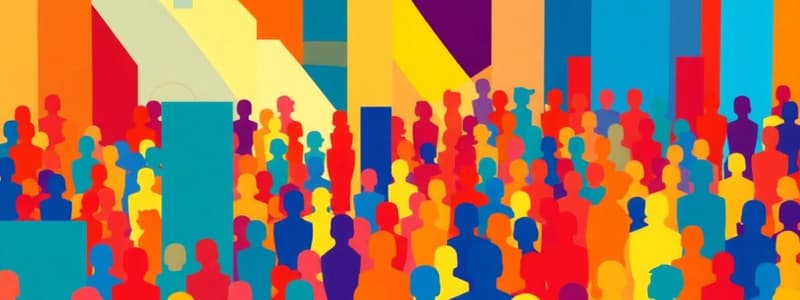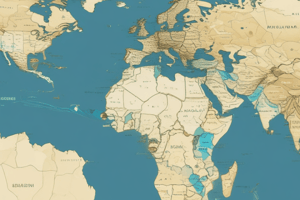Podcast
Questions and Answers
What does one dot represent in a dot map visualizing population distribution?
What does one dot represent in a dot map visualizing population distribution?
- 1 billion people
- 100,000 people (correct)
- 1 million people
- 10,000 people
Which country surpassed China in population in 2022?
Which country surpassed China in population in 2022?
- India (correct)
- Indonesia
- Brazil
- United States
What is the formula for calculating population density?
What is the formula for calculating population density?
- Land area/population growth rate
- Total population + land area
- Total population/land area in square kms (correct)
- Total area/total population
Which of the following Canadian provinces has the highest population density as of 2021?
Which of the following Canadian provinces has the highest population density as of 2021?
As of 2021, which country has the lowest population density among the following?
As of 2021, which country has the lowest population density among the following?
What is the population density of Canada in 2021?
What is the population density of Canada in 2021?
Which of the following locations has the highest reported population density?
Which of the following locations has the highest reported population density?
What phrase describes the region around Washington D.C. in relation to population density?
What phrase describes the region around Washington D.C. in relation to population density?
What is a primary factor that contributes to population growth in a region?
What is a primary factor that contributes to population growth in a region?
Which factor is NOT typically associated with populations on the periphery?
Which factor is NOT typically associated with populations on the periphery?
How is the Rate of Natural Increase (RNI) calculated?
How is the Rate of Natural Increase (RNI) calculated?
What is indicated by a population pyramid that has a wide base?
What is indicated by a population pyramid that has a wide base?
Which of the following accurately describes the characteristics of populations in the core?
Which of the following accurately describes the characteristics of populations in the core?
Which of the following is a common characteristic of the population composition in urban areas?
Which of the following is a common characteristic of the population composition in urban areas?
What does the crude birth rate measure?
What does the crude birth rate measure?
Which factor can lead to a decline in a population's growth rate?
Which factor can lead to a decline in a population's growth rate?
What term describes the process when refugees return to their home country?
What term describes the process when refugees return to their home country?
Which of the following is NOT considered a push factor influencing migration?
Which of the following is NOT considered a push factor influencing migration?
Which migration phenomenon involves the establishment of networks that facilitate further movement of migrants?
Which migration phenomenon involves the establishment of networks that facilitate further movement of migrants?
What was a significant push factor behind the Irish migration to North America in the 1840s?
What was a significant push factor behind the Irish migration to North America in the 1840s?
What does it mean when a migrant is deported?
What does it mean when a migrant is deported?
Which event in 1947 caused significant migration due to newly drawn national borders?
Which event in 1947 caused significant migration due to newly drawn national borders?
What are pull factors primarily characterized by?
What are pull factors primarily characterized by?
In the context of migration, which of the following best describes 'demand for work'?
In the context of migration, which of the following best describes 'demand for work'?
What is the definition of replacement level in terms of fertility?
What is the definition of replacement level in terms of fertility?
Which of the following factors has contributed to the declining fertility rates in Canada?
Which of the following factors has contributed to the declining fertility rates in Canada?
How is mortality rate defined?
How is mortality rate defined?
What is the primary purpose of restrictive population policies?
What is the primary purpose of restrictive population policies?
What was a significant impact of the One-Child Policy in China since its implementation in 1979?
What was a significant impact of the One-Child Policy in China since its implementation in 1979?
What does net migration represent?
What does net migration represent?
Which statement accurately describes temporary foreign workers?
Which statement accurately describes temporary foreign workers?
Which concept refers to the permanent relocation of individuals or groups across significant distances?
Which concept refers to the permanent relocation of individuals or groups across significant distances?
Which country is NOT mentioned as one of the highest receivers of remittances?
Which country is NOT mentioned as one of the highest receivers of remittances?
What does the term natural increase refer to?
What does the term natural increase refer to?
Which of the following measures is typically used to describe infant mortality?
Which of the following measures is typically used to describe infant mortality?
According to the United Nations’ Convention, what qualifies someone as a refugee?
According to the United Nations’ Convention, what qualifies someone as a refugee?
What is the primary characteristic of forced migration?
What is the primary characteristic of forced migration?
Which of the following best defines 'remittance'?
Which of the following best defines 'remittance'?
What is the relationship between net migration and total population increase?
What is the relationship between net migration and total population increase?
What motivates geographers to study migration?
What motivates geographers to study migration?
Flashcards are hidden until you start studying
Study Notes
Population Density
- Dot Map: Visualizes population distribution where each dot represents a specific number of people.
- Population Density: Measured as total population divided by land area.
- Examples of Low Population Density: Canada (4.35/km2), Mongolia (2.1), Australia (3.3)
- Examples of High Population Density: Bangladesh (1200/km2), Macau (China) (21000)
- Megalopolis: An urban area formed by the coalescence of several metropolitan areas, examples include the Washington D.C. to Boston corridor in the US.
Population Composition
- Population Pyramid: A graphic representation showing the age and sex composition of a population.
- Core Characteristics: Low/stable growth rates, low birth rates, low mortality rates, longer life expectancies.
- Periphery Characteristics: High growth rates, high birth rates, high mortality rates, and low life expectancies.
Population Growth
- Rate of Natural Increase (RNI): Calculated by subtracting the number of deaths from the number of births over a specific period.
- Crude Birth Rate: Number of live births per 1000 people in a given year.
- Crude Death Rate: Number of deaths per 1000 people in a given year.
- Fertility Rate: Average number of births per woman of childbearing age.
- Replacement Level: The level of fertility required for a population to replace itself, typically around 2.1 children per woman.
Declining Fertility Rates
- Factors contributing to declining fertility rates: Increasing female labor force participation, higher education levels among women leading to later marriages, and family planning.
Health and Population Dynamics
- Mortality Rate: Number of deaths in a year per 1000 people.
- Infant Mortality: Number of babies dying within their first year of life, usually per 1000.
- Life Expectancy: The average number of years a person is expected to live.
Geographies of Disease
- Factors influencing disease: Examples include the predicted population for 2035 in South Africa with and without AIDS.
Population and Government
- Restrictive Population Policies: Designed to lower the rate of natural increase.
- One-Child Policy: Introduced by the Chinese government in 1979 to slow population growth.
- Expansive Population Policies: Government policies that encourage large families and promote population growth.
Migration
- Migration: The movement of people resulting in the permanent relocation across significant distances.
- Transnational Migration: Migration across international borders.
- Emigration: Movement of people out of a country.
- Immigration: Movement of people into a country.
- Net Migration: Difference between immigration and emigration.
- Migrant: A person born in a country other than where they currently reside.
- Temporary Foreign Workers/Guest Workers: Individuals permitted to work in a country where they do not have permanent residence, subject to restricted rights and potential deportation.
- Remittances: Money sent back home by migrant workers.
Refugees
- Refugees: According to the UN Convention Relating to the Status of Refugees, they are individuals with well-founded fears of persecution based on race, religion, nationality, membership in a particular group, or political opinion seeking protection in another state.
- Asylum: The grant of shelter and protection to refugees.
Reasons for Migration
- Push Factors: Conditions that motivate people to leave a place, including unemployment, high cost of living, personal safety concerns, natural disasters, and climate change.
- Political Circumstances: Examples include the civil war in Sudan that displaced millions of people.
- Armed Conflict and War: Instances like the conflict between Hutu and Tutsi ethnic groups in Rwanda, causing over 1 million refugees.
- Environmental Conditions: The Irish Potato Famine in the 1840s and volcanic eruptions in Montserrat in 1995 leading to large migrations.
- Culture and Traditions: The partition of British India in 1947 led to significant migrations based on religious affiliations.
- Pull Factors: Conditions that attract migrants to a location, such as positive perceptions of destinations, kinship connections, opportunities, and freedom.
- Demand for Work: Examples include women from the Philippines working in childcare and domestic work.
Chain Migration and Kinship Links
- Chain Migration: The concept that the migration of an individual or family can create easier pathways for others to follow.
Government and Migration
- Deportation: The removal of migrants living illegally in a country.
- Border Walls: Examples include the wall built between the US and Mexico.
Politics of Immigration
- Immigration Policies: Government policies that control and regulate international migration.
Studying That Suits You
Use AI to generate personalized quizzes and flashcards to suit your learning preferences.




